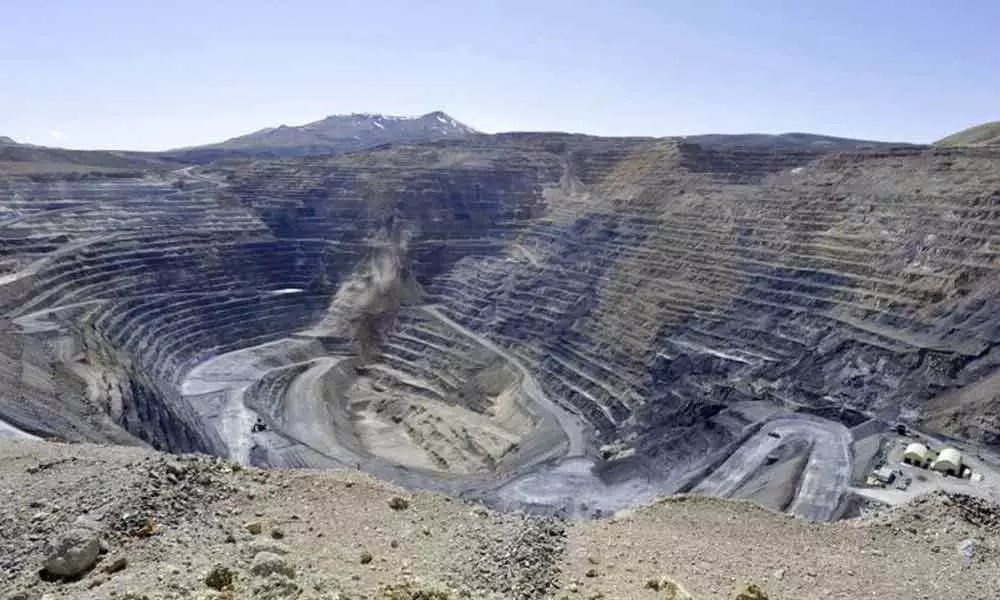Live
- Seven-day national mourning in respect of Dr. Manmohan Singh
- 'I've lost a mentor and guide': Rahul Gandhi grieves demise of Dr. Manmohan Singh
- 'Great loss for all of us': President Droupadi Murmu mourns Manmohan Singh's demise
- Dr Singh presented milestone budget of 1991 which liberalised Indian economy: FM Sitharaman
- PM Modi condoles demise of Dr. Manmohan Singh
- Former Prime Minister Manmohan Singh Dies at 92: A Legacy of Economic Reforms
- Nagesh Trophy: Telangana, Gujarat dominate action on Day 4 with easy wins
- Get Ready for Dreame Technology’s Year-End Amazon Sale – Big Savings on Smart Home Products
- FIR registered as 4 voter forgery cases come to light in Delhi's Okhla constituency
- Ayodhya Ram temple to host majestic anniversary celebrations on Jan 11 with devotional, cultural programmes
Just In
New booster package on anvil to lift mining sector


The government is planning another booster policy dose to attract investments in the mining sector, according to official sources here.
New Delhi: The government is planning another booster policy dose to attract investments in the mining sector, according to official sources here.
Mining has been identified as a critical activity that needs a big push to help other capital intensive and employment generating industries. The sector is in thye grip of a slowdown that has seen declining investment and production.
The informed sources said that the mining package would revolve around allowing existing operations to flourish while giving sops to boost new operations.
According to officials, the concept of captive mines would be diluted to allow all mines to use the mineral resources either for captive consumption of end-use plants or sold for commercial purposes. This would be a major reform that would allow companies such as Tatas, Vedanta and JSW to commercially sell out from their captive iron ore mines for higher gains.
Already, state-owned SAIL has been permitted to commercially sell iron ore from its captive mines.
A high level committee headed by the NITI Aayog Vice Chairman and having top representation from the Finance, Mines, Coal and Environment Ministries has suggested that all mines henceforth be auctioned for commercial production. For companies taking mines largely for captive use, 50 per cent of production from mines would be permitted to be sold in the open market.
The package would also include changes in law that would offer full mining leases to global companies which decide to take up the risk of finding new mineral resources in unprospected areas.
Currently, the initial exploration activity (reconnaissance permit) is given on non-exclusive basis, meaning an explorer may not automatically get the lease to mine the mineral. This would change under a new composite mineral mining licence where the explorer would automatically get to mine and reap benefit from its find.
Also, the investor would be free to sell his mining licence after one year of mining if 15 per cent of the agreed investment has already been spent.
In yet another relief for the mining sector, the government is set to make provisions in the mining legislations that would allow transfer of captive mining rights in favour of the purchaser of an end-use plant. This would be done by allowing transfer of existing non-captive mining leases (granted other than auction) in any merger and acquisition activity in the sector. Besides, transfer of lease of captive mines would also be allowed without payment of 80 per cent royalty.
Any extension of mining lease for captive mines will come along with extension of environment and forestry clearances, unless there are changes mining areas. A purchaser of a mine can also use the same clearances for a time period and plan on taking fresh clearances later.
Mining would also be given a level playing field and put an end to reservation of areas for government entities.
Moreover, areas that are yet to be developed by government companies, or where no activity has taken place for three years, can be put to auction for all interested entities in government and the private sector. A proposal is also being considered to allow private sector in beach sand mining.
The package could also deal with lowering of taxes on the mining sector. The effective tax rate in India is 64 per cent for existing mines, and 60 per cent for new mines granted through auction. This compares with as low as 31.3 per cent in Mongolia and highest at 45.5 per cent in Indonesia, as per a Federation of Indian Mineral Industry report.
A high level committee has recommended rationalisation of taxes for the sector that includes discontinuation of net present value (NPV) levy at exploration and prospecting stages, as there is hardly any damage to ecology or diversion of forest land. Also, the Centre would ask states to avoid levying additional financial burden on miners.
The issue of higher bidding has been addressed by the decision on a stage-by-stage bidding process involving revenue sharing and production profile.
There is also a plan to put a mining regulator at the Central and state levels to regulate mining activity and prevent illegal mining from flourishing. Though the contours of the mining regulator would be finalised later, it is expected to be a two-tier structure with the National Mineral Regulatory Authority at the Centre and state mining regulatory authority to cover minor minerals at the state level.

© 2024 Hyderabad Media House Limited/The Hans India. All rights reserved. Powered by hocalwire.com






